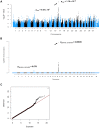An ARHGEF10 deletion is highly associated with a juvenile-onset inherited polyneuropathy in Leonberger and Saint Bernard dogs
- PMID: 25275565
- PMCID: PMC4183422
- DOI: 10.1371/journal.pgen.1004635
An ARHGEF10 deletion is highly associated with a juvenile-onset inherited polyneuropathy in Leonberger and Saint Bernard dogs
Abstract
An inherited polyneuropathy (PN) observed in Leonberger dogs has clinical similarities to a genetically heterogeneous group of peripheral neuropathies termed Charcot-Marie-Tooth (CMT) disease in humans. The Leonberger disorder is a severe, juvenile-onset, chronic, progressive, and mixed PN, characterized by exercise intolerance, gait abnormalities and muscle atrophy of the pelvic limbs, as well as inspiratory stridor and dyspnea. We mapped a PN locus in Leonbergers to a 250 kb region on canine chromosome 16 (Praw = 1.16×10-10, Pgenome, corrected = 0.006) utilizing a high-density SNP array. Within this interval is the ARHGEF10 gene, a member of the rho family of GTPases known to be involved in neuronal growth and axonal migration, and implicated in human hypomyelination. ARHGEF10 sequencing identified a 10 bp deletion in affected dogs that removes four nucleotides from the 3'-end of exon 17 and six nucleotides from the 5'-end of intron 17 (c.1955_1958+6delCACGGTGAGC). This eliminates the 3'-splice junction of exon 17, creates an alternate splice site immediately downstream in which the processed mRNA contains a frame shift, and generates a premature stop codon predicted to truncate approximately 50% of the protein. Homozygosity for the deletion was highly associated with the severe juvenile-onset PN phenotype in both Leonberger and Saint Bernard dogs. The overall clinical picture of PN in these breeds, and the effects of sex and heterozygosity of the ARHGEF10 deletion, are less clear due to the likely presence of other forms of PN with variable ages of onset and severity of clinical signs. This is the first documented severe polyneuropathy associated with a mutation in ARHGEF10 in any species.
Conflict of interest statement
Both the University of Minnesota and the University of Bern are offering a genotyping test for LPN1 in their respective laboratories and proceeds from these tests go toward ongoing canine genetic research. The authors declare that no other competing interests exist.
Figures




References
-
- Pareyson D (1999) Charcot-marie-tooth disease and related neuropathies: Molecular basis for distinction and diagnosis. Muscle Nerve 22: 1498–1509. - PubMed
-
- Meyer Zu Horste G, Nave KA (2006) Animal models of inherited neuropathies. Curr Opin Neurol 19: 464–473. - PubMed
-
- Shelton GD (2007) What's new in muscle and peripheral nerve diseases? Vet Comp Orthop Traumatol 20: 249–255. - PubMed
-
- Coates JR, O'Brien DP (2004) Inherited peripheral neuropathies in dogs and cats. Vet Clin North Am Small Anim Pract 34: 1361–1401. - PubMed
Publication types
MeSH terms
Substances
Grants and funding
LinkOut - more resources
Full Text Sources
Other Literature Sources

